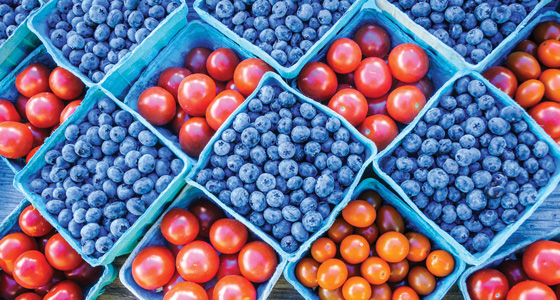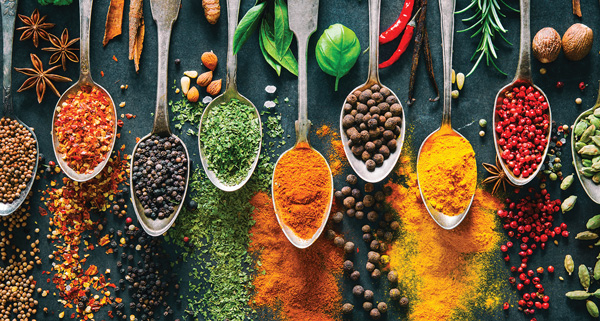Decontaminating produce with ultraviolet light; China leads in salty snack innovation
NEWS

Decontaminating produce with ultraviolet light
A study published in the Journal of Food Science investigated two emerging decontamination technologies for fresh produce—pulsed light (PL) and ultraviolet light (UV), in combination with washing (WPL and WUV). The researchers tested blueberries, grape tomatoes, and iceberg lettuce shreds to represent fresh vegetables and fruits with smooth and rough surfaces.
Using Salmonella as a model microorganism, the researchers inoculated the produce using spot inoculation and dip inoculation to simulate potential contaminations during irrigation, harvest, transportation, and processing. Tests were conducted with two intensity levels of PL and UV for one and two minutes.
For all three types of fresh produce, WPL and WUV showed similar Salmonella inactivation effects. For spot-inoculated fresh produce, WPL and WUV treatments reduced 4.5 to 5.7, 4.4 to 5.4, and 1.9 to 3.1 logs of Salmonella on blueberries, tomatoes, and lettuce shreds, respectively. For dip-inoculated fresh produce, WPL and WUV treatments reduced 1.8 to 2.3, 1.9 to 2.5, and 1.9 to 2.6 logs of Salmonella on blueberries, tomatoes, and lettuce shreds, respectively. The majority of the WUV and WPL treatments could eliminate Salmonella in the wash water for blueberries and tomatoes but not for lettuce.
The researchers concluded that the two light systems showed a similar decontamination effect on fresh produce, demonstrating that the UV system could be used to replace the PL system to reduce equipment cost.
China leads in salty snack innovation
Asia is home to four of the world’s top five innovators in salty snacks, with China accounting for 11% of the world’s salty snack product launches in 2018, according to research from Mintel. The United States follows with 8% of new product launches, India with 7%, and Indonesia and Japan with 5% each.
One area of growth for the global snack industry lies in flavor migration. For example, chocolate-flavored salty snacks that were originally popularized in the United States are proving to be more popular in Asia. In 2018, more chocolate-flavored salty snacks were launched in Japan (12%) than in the United States (8%).
Flavor innovation is also driving the global snack industry, and Mintel research reveals that two-fifths of urban Indonesians would like to try dishes with a combination of sweet and savory flavors, while half of urban Chinese consumers are interested in snacks with an exotic flavor (e.g., sweet and salty).
“As competition in the snack food industry stiffens, brands need to offer new and pleasantly surprising products to stand out,” says Marcia Mogelonsky, director of insight, Mintel Food & Drink. “Exploring different styles of flavor combination can be interesting, particularly as it introduces the element of novelty to consumers. For manufacturers in Asia, success will rely on finding the right balance between sweet and savory—especially with current interest levels among Asian consumers.”
 Healthy growth for seasonings and spices
Healthy growth for seasonings and spices
The global seasonings and spices market size is expected to reach $20.5 billion by 2025, expanding at a compound annual growth rate (CAGR) of 3.9% during the forecast period, according to a new report by Grand View Research. Changing taste preferences, rising disposable income, and the large number of international and local players are among the trends escalating market growth.
Increasing demand for authentic cuisines on a global level is bolstering the usage of spices and herbs in sauces and dressings. Changing consumer preferences related to flavor in foods and snacks is projected to prompt manufacturers to introduce products that are appealing, high-quality, and reliable, thereby maintaining consistent standards globally.
Ready-to-use spice mixes are gaining popularity among consumers, as they save time and effort and provide consistency in taste. Hectic lifestyles, a growing demand for convenience in food preparation, and increasing disposable incomes are also driving popularity. In addition, seasoning and spice companies are starting advertising campaigns to encourage consumers to try recipes at home.
Energy drink consumption on the rise
Over the past decade, energy drink consumption in the United States has increased substantially among adolescents, young adults, and middle-aged adults, according to a new study appearing in the American Journal of Preventive Medicine. The study found that energy drink consumers had significantly higher total caffeine intake compared with non-consumers, and the beverages represented a majority of their total daily caffeine.
Energy drinks have a caffeine content that ranges from 50 mg to 500 mg per serving, compared with 95 mg for an 8-ounce cup of coffee. Although moderate caffeine intake (up to 400 mg/day for adults and 100 mg/day for teens) is considered safe, higher volumes may pose health risks such as mental health strain and increased blood pressure, according to the study authors.
“The increasing use of energy drinks, especially among young adults, is cause for concern and warrants continued study and surveillance,” explained senior author Sara N. Bleich, Department of Health Policy and Management, Harvard T.H. Chan School of Public Health. “Although the beverages are marketed to reduce fatigue and improve physical and mental performance, frequent consumption of these highly caffeinated and sugary beverages has been linked to negative health consequences,” she adds.
U.S. Food and Drug Administration (FDA) regulations require that energy drink labels indicate if the product contains caffeine, but the FDA does not impose a caffeine limit or require reporting of the actual level of caffeine. While some energy drink companies are taking part in voluntary labeling initiatives, Bleich noted, “Our findings point to the need for an evidence-based upper caffeine limit and consistent labeling on these beverages to reduce the potential negative health impact on consumers.”
But it tastes so good!
Scientists at the University of North Carolina School of Medicine may have uncovered the reason why it’s so hard to stop eating tasty, calorie-dense foods even after we are full. Thomas Kash and colleagues discovered a specific network of cellular communication, called the mammalian brain circuit, that emanates from the emotion-processing region of the brain and motivates mice to keep eating tasty food even though their basic energy needs have been met.
The circuit is a by-product of evolution, when calorie-rich meals were scarce and brains were wired to devour as many calories as humanly possible. “The circuit seems to be the brain’s way of telling you that if something tastes really good, then it’s worth whatever price you’re paying to get to it, so don’t stop,” Kash notes.
Recent experiments have suggested that our wiring for pleasure-based, or hedonic, feeding involves nociceptin, a small protein that works as a signaling molecule in the mammalian nervous system. Compounds that block nociceptin activity curb hedonic bingeing on tasty, calorie-rich foods. Thus, drug developers have eyed these antagonists as potential anti-obesity, anti-binge-eating drugs, and researchers have been eager to identify the specific brain circuits through which they work.
Although there are multiple nociceptin circuits in the brain, Kash and colleagues observed that one in particular became active when the mice binged on calorie-rich food. The circuit projects to different parts of the brain, including those known to regulate feeding, but starts in an emotion-processing region called the central amygdala. Deleting about half of the nociceptin-making neurons in this circuit reduced the mice’s bingeing and kept their weight down when they had access to rich food, without affecting their intake of ordinary chow.


